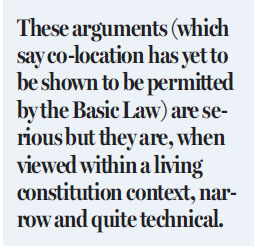Opponents of co-location ignore 'living law' model
Updated: 2018-02-02 06:21
(HK Edition)
|
|||||||
Richard Cullen cites Australia's constitution, which is more than a century old but drastic technological and geopolitical changes called for extensive re-interpretation to fit times
The intense debate over co-location of Hong Kong and Chinese mainland immigration and customs controls at the Guangzhou-Shenzhen-Hong Kong Express Rail Link's West Kowloon terminus shows no sign of slackening off. Supporters rely significantly on the National People's Congress Standing Committee's statement on co-location's legal validity, made in December last year. This perspective stresses the sovereign authority of the NPCSC within the "one country, two systems" political-legal hierarchy governing the status of the Hong Kong Special Administrative Region within the People's Republic of China.
Critics, meanwhile, have focused on the claimed lack of Basic Law foundation to support co-location. These assessments use an interpretive emphasis derived from Hong Kong's common law system.
Yet a broad examination of public law interpretive methods in common law jurisdictions reveals a notably expansive approach, which also lends weight to arguments made in favor of the organic evolution of the Basic Law to address new circumstances - a view which underpins the NPCSC advice on validity of co-location.
The "living constitution" theory developed in the United States almost 100 years ago by constitutional scholars and judges stressed that a constitution is notably more akin to a living organism than to a complex machine.

Australia presents an informative case study of how a common law jurisdiction may set about adapting its fundamental public law to fit significantly changed circumstances - in keeping with the spirit of this living constitution theory.
Australia arose as a new nation on Jan 1, 1901. The Australian federal constitution created a new, central, commonwealth government and converted the then six colonies into six new Australian states. Provisions in the constitution made it very difficult to amend the constitution in a formal way. The original Australian drafters of the constitution envisioned a set of relatively powerful state governments coexisting with the new commonwealth government, which would largely confine itself to looking after such matters as defense, foreign affairs, a new monetary union and maintaining free trade within Australia.
Within about 20 years, the High Court of Australia began to turn this political order on its head through a constitutional interpretation handing extensive powers over industrial regulation to the commonwealth government. That process has continued almost without let-up ever since. The commonwealth now dominates public policymaking in areas such as taxation, public borrowing, corporate regulation, competition law, labor regulation, welfare, education, healthcare and major infrastructure development.
Australia is, consequently, a profoundly different political entity today compared with the Australia which endured until 1920. Almost all of this massive change has been secured by relying on adaptive, public law interpretative norms. Meanwhile, the formal wording of the Australian constitution has remained largely intact. This remarkable constitutional transformation was set running by events never foreseen by the original drafters, including the outbreak of World War I.
Almost 20 years ago, Hong Kong's Court of Final Appeal laid down a set of primary principles designed to shape the interpretation of the Basic Law of the HKSAR. In a pivotal right of abode case, Chief Justice Andrew Li Kwok-nang stipulated that, with a constitutional document such as the Basic Law, a purposive approach is needed as gaps and ambiguities are bound to arise in such an instrument given its necessary generality. He also cautioned against using a technical, narrow or rigid approach when considering the language of the Basic Law. The chief justice did not rely directly on the living constitution theory in this seminal exposition but these CFA formulations are in harmony with that theory.
The feasibility study for the first high-speed rail line on the mainland did not commence until several years after the promulgation of the Basic Law, and well after its drafting had been concluded. There was, thus, zero consideration given in the Basic Law to the linkage of the HKSAR to this rail network.
These fresh facts on the ground are different in their particular nature from those rapid economic, technical and political factors which have driven such massive, interpretative change to Australia's fundamental public law over the past 100 years. But they share the quality of changing, unforeseen circumstances applying pressure for rational, organic constitutional evolution.
Those arguments which say co-location has yet to be shown to be permitted by the Basic Law rely, above all, on a lack of explained particular authority in the Basic Law for co-location (a previously unforeseen need) and the Basic Law protections against the general application of mainland law in the HKSAR. These arguments are serious but they are, when viewed within a living constitution context (coupled with the cautionary words from the Court of Final Appeal), narrow and quite technical. Had similar arguments prevailed (and they were made) in Australia a century ago this would have conspicuously restrained the country's development and adaptation to a constantly changing world.
The author is a visiting professor in the Faculty of Law at the University of Hong Kong and an adjunct professor in the Faculty of Law at the University of Western Australia.
(HK Edition 02/02/2018 page8)